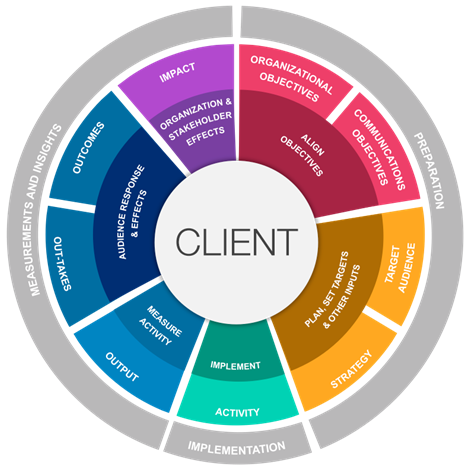It seems like there’s a framework for everything these days, and PR measurement is certainly no stranger to a framework. But despite this (or, perhaps, because of it), it can be overwhelming figuring out where to start. How do you design a framework that will help you understand your communications plan and where evaluation fits into it? How do you know what metrics to look for? How do you show the value of PR and the impact you’ve had on your organisation?
These are all big questions, and enough to make even the most seasoned PR veteran baulk.
I recently presented my approach to PR measurement frameworks at #WaddsCon, the monthly free webinar series run by guru of all things comms, Stephen Waddington.
There are a wide range of measurement frameworks out there, but they generally follow the same broad flow: start with knowing what you’re trying to achieve, plan and implement your activities, then report on them. At CARMA, we often use a version based on the AMEC framework, but simplified:
AMEC:

CARMA:

We start with objectives – what are you trying to achieve – then move to the activities you’ll undertake, then to outputs (coverage results) and outcomes (audience metrics), the measurement bit. This is all under the influence of inputs – the environment you’re operating within, e.g., benchmarking data, external factors, target audiences etc.
This is a pretty clear and straightforward flow which helps clients see everything planned out on a page, so that it’s easier to understand how things link together.
But when it comes to choosing which metrics go into the outputs and outcomes columns, it can quickly start to get muddled. Lots of different numbers come out of the woodwork and soon, the framework can start to look like an encyclopaedia of metrics. It’s easy for clients to become overwhelmed by what to make of any of these numbers and to be in danger of death by data.
That’s why I like to add an additional layer to the framework, based on the mantra of see, think, do.
At its most basic, PR is trying to do three things – generate awareness amongst your target audience (see), create a perception and level of interest within that audience (think), and facilitate an action for the audience to take (do). Obviously, a comms/marketing funnel is more nuanced than this, but PR tends to mostly live at the top end of that funnel, generating awareness, interest/consideration, and action.
Adding this layer to a framework helps to focus the mind on why any activity is actually being done, and ensure that the metrics you choose speak directly to this. It avoids extraneous numbers being added to the mix, just because it’s possible to measure them, and it helps clients explain what any given number means.
It’s a simple tool to ensure that we don’t just look at one type of metric to the detriment of the others; it helps clients tell clearer stories about the impact they’ve had on the business; it allows PR teams to demonstrate where they fit into the rest of the comms function, and ultimately it keeps everyone – clients and us analysts alike – focused on measuring what matters.